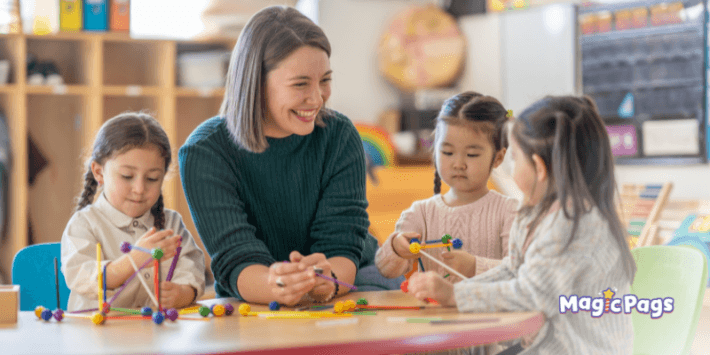Best Art Activities for Kindergartners: Fun and Creative Projects for the Classroom
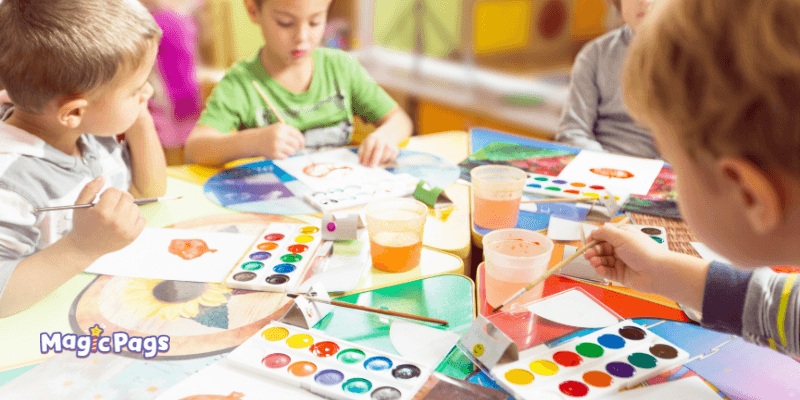
Art is an essential part of early childhood education. It helps children think creatively, express their feelings, and develop important skills. When kids participate in art activities for kindergartners, they use their imagination and practice problem-solving. Research shows that art improves fine motor skills, helps children focus, and teaches them patience. According to The Art of Creating, art activities encourage kids to make choices, develop focus, and learn perseverance.

In a kindergarten art class, children learn to use different materials, such as paints, crayons, and clay. They explore colors, shapes, and patterns, which helps them understand the world around them. Teachers often include kindergarten art projects that allow kids to experiment with different textures. These activities also improve their hand eye coordination, making them better at tasks like writing and cutting.
Simple activities, such as easy art for kindergartners, require little preparation but offer many benefits. Projects like finger painting, collage making, and crafting with paper keep children engaged. Arts and crafts for kindergarteners also encourage teamwork, as children learn to share supplies and cooperate with their classmates. Teachers can design kindergarten art lessons that introduce new concepts in a fun way, helping children enjoy learning while developing their creativity.
This guide includes some of the best art projects for kindergarteners that are simple to organize. Whether you are looking for fun projects for kindergartners or creative ideas to use in the classroom, you will find plenty of inspiration here.

1.Why is Art Important for Kindergarten?
Art helps small children develop in many ways. In a kindergarten art class, kids improve their ability to think critically and solve problems. They also strengthen their hand eye coordination by painting, cutting, and gluing. Activities like kindergarten painting and crafts introduce them to different colors, textures, and shapes. This exposure helps their brains grow and improves their ability to recognize patterns.
According to Michigan State University, creative activities help children learn how to make decisions and solve problems. Another study by PBS explains that art activities for kindergarten help kids understand and express their emotions better. When children create art, they learn how to communicate their feelings visually.
Making art also builds confidence. When kids complete art and craft, they feel proud of their work. This sense of accomplishment makes them more willing to try new things. Creating art allows them to think independently and make their own choices. That is why crafts for kindergarten should be a regular part of early education.
By including art in the classroom, teachers give children the opportunity to grow emotionally, socially, and mentally. Simple activities, such as drawing, painting, and crafting, offer an enjoyable way to learn while improving important life skills.
Top 10 Art Activities for Kindergarten Classrooms
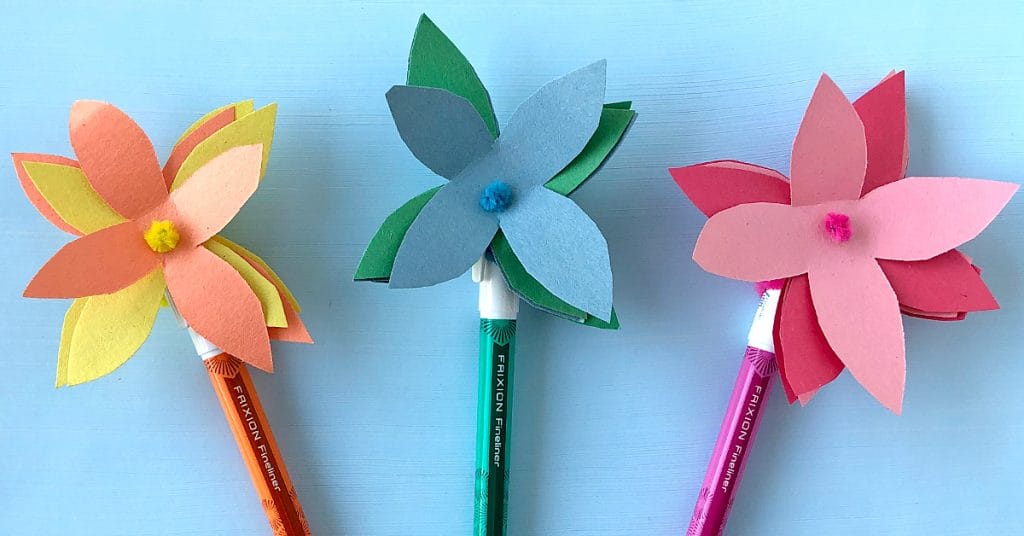
1. Flower Pens Activity
Making flower pens is a fun and creative craft that allows children to transform an ordinary pen into a beautiful and colorful flower. This activity combines art and functionality, giving kids the chance to personalize their writing tools in a unique way.
You’ll need:
- A pen for the base of the flower
- Green tape to wrap the stem
- Scissors for cutting materials
- Paper or fabric for the petals
- Glue or tape to attach the petals
They start by choosing a pen and wrapping it with green tape to make it look like a flower stem. Then, they cut out petal shapes from paper or fabric. They can use bright colors to make their flower pens stand out. After cutting the petals, they carefully attach them to the top of the pen using glue or tape. They can arrange the petals in layers to create a full and realistic flower. Some children may enjoy adding extra decorations like glitter, small beads, or stickers to make their flower pens even more special. Others may prefer keeping the design simple and elegant.
This activity has many benefits for children. It helps improve their fine motor skills as they cut, wrap, and glue the materials. It also encourages creativity by allowing them to design their own unique flowers. Children can practice patience and focus while carefully arranging the petals. It also makes writing more exciting and fun by adding a personal touch to their everyday tasks. Most importantly, it gives them a sense of pride when they see and use their handmade flower pens.
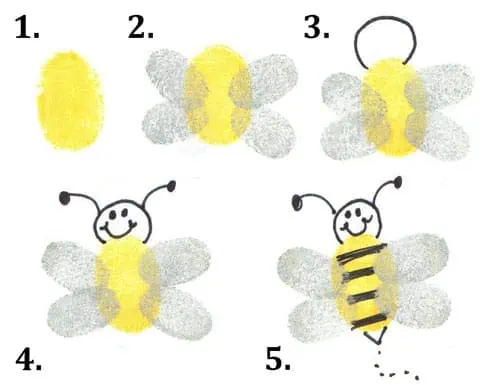
2. Thumbprint Bugs Activity
Creating thumbprint bugs is a fun and easy art project that allows children to use their fingerprints to make colorful and creative bug designs. This activity helps kids explore art in a hands-on way while using simple materials.
You’ll need:
- Thick paper for the artwork
- Non-toxic paint for thumbprint bugs
- Markers for adding details
- A thin brush for fine details
They start by dipping their thumbs into paint. Then, they gently press their thumb into a piece of paper to create the body of the bug. They can make multiple thumbprints to create different shapes and sizes. After the paint dries, they use markers or a thin brush to add details. They can draw legs, antennae, wings, or even tiny eyes to bring their bugs to life. Some children may enjoy making realistic insects like ladybugs, bees, or caterpillars. Others might prefer to create imaginary bugs with unique colors and patterns.
This activity has many benefits for children. It helps improve fine motor skills as they press, paint, and draw small details. It also encourages creativity by allowing kids to design their own bugs in different styles. Children can learn about different insect species while having fun with art. It provides a sensory experience as they feel the texture of the paint on their fingers. Most importantly, it gives them a sense of accomplishment when they see their finished thumbprint bug artwork.
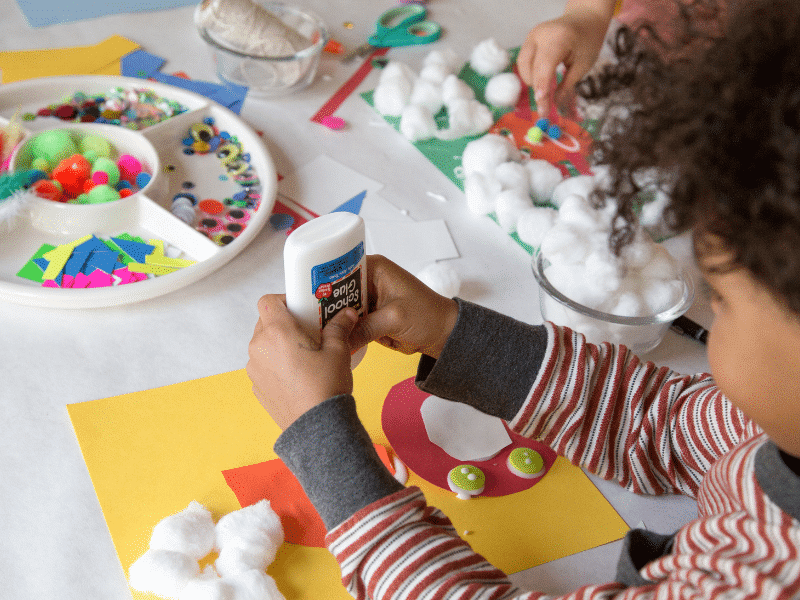
3. Collage Creations Activity
Collage making is a fun and creative activity for kids. It allows them to use different materials to create colorful and unique artwork. They can cut or tear paper, fabric, magazines, or other textured materials. Then, they can glue these pieces onto a surface to form a picture or abstract design. Children can arrange the materials in any way they like.
You’ll need:
- A base surface like cardboard or thick paper
- Glue for attaching materials
- Scissors for cutting shapes
- A variety of colorful materials, such as old magazines, newspapers, fabric scraps, colored paper, stickers, or natural items like leaves and twigs
They start by choosing a base surface like cardboard or thick paper. Then, they pick different materials such as colored paper, magazine cutouts, fabric scraps, or even leaves and twigs. They can cut or tear these materials into different shapes and sizes. Next, they use glue to attach the pieces onto their base, arranging them in any way they like. Some children may create pictures of animals, flowers, or landscapes, while others might make abstract designs with bright colors and patterns. After finishing their collage, they can add stickers or draw extra details to make their artwork even more special.
This activity has many benefits for children. It improves their creativity by allowing them to explore different materials and designs. It also strengthens fine motor skills as they cut, tear, and glue small pieces. They develop patience and concentration as they carefully arrange each piece. At the same time, they learn about colors, shapes, and textures in a hands on way. Creating a collage is not just an art project, but also a great way for kids to express their emotions and ideas.

4. Finger Painting Fun Activity
Finger painting is a fun and engaging activity that allows children to explore colors and textures in a creative way. It does not require any brushes or tools, only their hands and fingers.
You’ll need:
- Thick paper or a canvas to paint on
- Non toxic, washable paints in different colors
- A wet cloth or paper towel for easy cleanup
- Little fingers and big imaginations
Kids start by dipping their fingers into different colors of paint. Then, they press, smear, and dab the paint onto paper or a canvas. They can create simple shapes, patterns, or even detailed pictures. Some children may enjoy making abstract designs by blending colors together. Others may prefer to paint specific things like trees, flowers, animals, or the sun. There are no strict rules in finger painting, which makes it a great way for kids to express themselves freely.
Finger painting has many benefits for children. It improves hand eye coordination as they move their fingers to create shapes. It also strengthens fine motor skills, helping with later writing and drawing activities. This activity encourages creativity because children can explore colors and designs in their own way. It also provides a sensory experience, as they feel the smooth and cool texture of the paint. Most importantly, finger painting gives kids the freedom to express their emotions through art in a fun and playful way.

5. Homemade Clay Activity
Making homemade clay is a fun and hands on activity that allows children to create their own sculpting material. Instead of buying clay from a store, kids can mix simple ingredients to make a soft and moldable dough at home.
You’ll need:
- Flour, salt, and water for making the clay
- A mixing bowl and spoon for blending ingredients
- A flat surface for shaping creations
- Beads, buttons, or small natural materials like leaves or twigs for decoration
They start by combining flour, salt, and water in a bowl. Then, they mix and knead the ingredients until the dough becomes smooth and easy to shape. If they want colorful clay, they can add food coloring or natural dyes. They can also mix in a few drops of essential oils for a pleasant scent. Once the clay is ready, they can use their hands or simple tools to shape it into different objects. They can create animals, flowers, small bowls. Some kids may enjoy using cookie cutters to make fun shapes. Others might prefer rolling and twisting the clay into unique sculptures.
This activity has many benefits for children. It helps them develop fine motor skills as they knead, roll, and shape the clay. It also improves their hand strength, which is important for writing and drawing. Making and molding clay encourages creativity by allowing kids to turn their ideas into real objects. It also teaches patience as they wait for their clay to dry and harden. Most importantly, it gives them a sense of pride when they see their handmade creations come to life.

6. Leaf Painting Activity
Leaf painting is a creative and exciting activity that allows children to explore nature and art at the same time. This activity encourages kids to use leaves as their painting tools instead of brushes.
You’ll need:
- Leaves for printing
- Thick paper as a canvas
- Non-toxic, washable paints for stamping
- Brushes or sponges to apply the paint
- A damp cloth or paper towel for easy cleanup
They start by collecting different types of leaves from their backyard, a park, or a garden. They can choose leaves of various shapes and sizes to make their artwork more interesting. Once they have their leaves, they apply paint to one side using a brush or their fingers. Then, they press the painted side onto paper to create a beautiful leaf print. When they lift the leaf, a unique pattern appears on the paper. They can repeat this process using different colors and leaf shapes to create a colorful collage. Some children may enjoy arranging the prints in a pattern. Others may use them to design animals, trees, or abstract art.
Leaf painting has many benefits for children. It improves their observation skills as they explore different leaf shapes and textures. It also strengthens their fine motor skills as they carefully press and lift the leaves. This activity encourages creativity because there are endless ways to arrange and design the prints. It also provides a sensory experience as kids feel the smooth, rough, or bumpy textures of the leaves. Most importantly, it helps them connect with nature while having fun with art.
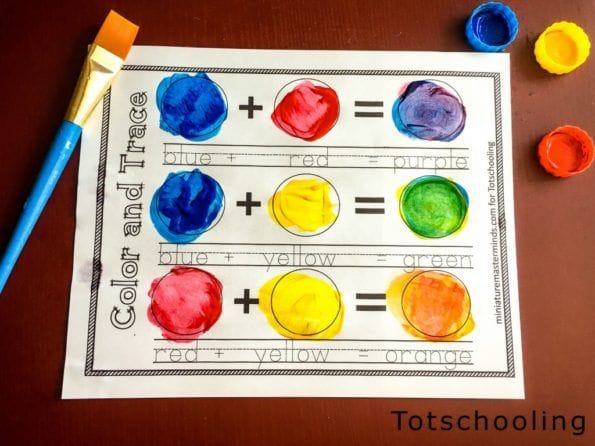
7. Mixing Paint Activity
Mixing paint is a fun and engaging activity that helps children explore colors in a creative way. This activity allows kids to experiment with different shades and discover how colors change when combined.
You’ll need:
- A palette or plate for mixing colors
- Paintbrushes for applying paint
- Thick paper as a canvas
- Non-toxic, washable paints for creativity
- Sponges or cotton swabs for exploring textures
They start with basic primary colors like red, blue, and yellow. Then, they mix two colors together to create a new one. For example, mixing red and yellow makes orange. Combining blue and yellow creates green. Mixing red and blue results in purple. Children can also try adding white to make lighter shades or black to create darker tones.
This activity has many benefits for children. It helps them develop an understanding of colors and how they interact. It also improves fine motor skills as they dip, mix, and paint with precision. Mixing paint encourages creativity because kids can create endless shades and explore their artistic ideas. It also provides a sensory experience as they watch colors blend and change. Most importantly, it gives children the freedom to experiment, make choices, and express themselves through art.

8. Mosaic Artwork Activity
Mosaic artwork is a fun and creative activity that allows children to create beautiful designs using small pieces of different materials. This activity helps kids explore patterns, shapes, and colors while improving their artistic skills.
You’ll need:
- A base surface for the collage
- Glue for attaching materials
- Small colorful materials like colored paper, magazines, fabric scraps, or natural items like leaves or pebbles
- Glitter, buttons, or stickers for extra details
They start by cutting or tearing small pieces of colored paper, fabric, or other materials. Then, they arrange these pieces on a base surface like cardboard or thick paper. They can create pictures, patterns, or abstract designs by gluing the pieces down. Some children may enjoy making animals, flowers, or landscapes. Others might prefer to create colorful geometric patterns.
This activity has many benefits for children. It helps them develop patience as they carefully place each piece in the right spot. It also strengthens fine motor skills as they cut, tear, and glue small materials. Creating mosaics encourages creativity by allowing kids to design their own unique patterns and pictures. It also improves problem-solving skills as they decide where each piece should go. Most importantly, it gives children a sense of accomplishment when they see their finished artwork.
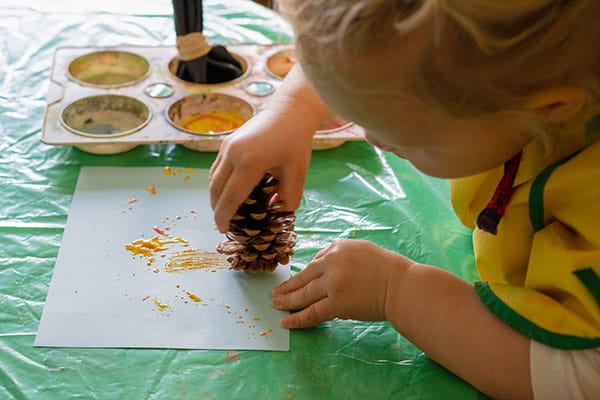
9. Nature Printmaking Activity
Nature printmaking is an exciting and hands-on activity that allows children to explore the beauty of nature while creating unique artwork. This activity encourages kids to use natural objects as stamps to make creative prints on paper.
You’ll need:
- Thick paper for printing
- Non-toxic, washable paints for stamping
- A variety of natural materials for unique textures
- Brushes or sponges to apply the paint evenly
- A damp cloth or paper towel for easy cleanup
They start by collecting different items from nature, such as leaves, flowers, twigs, or even small fruits and vegetables. Each object has a unique texture and shape, making every print special. Once they have their materials, they dip one side of the object into paint. Then, they gently press it onto paper to leave an imprint. When they lift the object, a beautiful and detailed pattern appears. They can repeat this process using different colors and materials to create a layered design. Some children may prefer arranging their prints into patterns. Others may enjoy using them to create trees, flowers, or abstract artwork.
Nature printmaking has many benefits for children. It helps them develop their observation skills as they notice the shapes and patterns in natural objects. It also strengthens their fine motor skills as they press and lift the materials carefully. This activity encourages creativity because there are endless ways to arrange and design the prints. It also provides a sensory experience as kids feel the different textures of leaves, flowers, and other objects. Most importantly, it helps them connect with nature in a fun and artistic way.
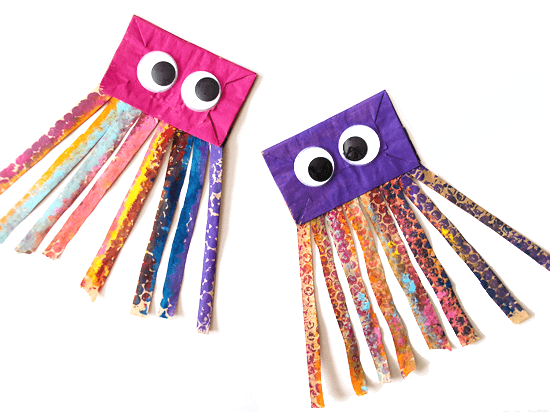
10. Paper Bag Jellyfish Activity
Creating a paper bag jellyfish is a fun and simple craft that allows children to explore their creativity while learning about sea animals. This activity involves turning an ordinary paper bag into a colorful jellyfish with long, flowing tentacles.
You’ll need:
- A paper bag for the jellyfish body
- Scissors for cutting shapes
- Glue for attaching decorations
- Markers for adding details
- Paints, stickers, or glitter for extra decoration
Kids start by choosing a paper bag and decorating it with paints, markers, or stickers. They can make their jellyfish bright and colorful by adding patterns, dots, or even glitter. Once the bag is decorated, they carefully cut strips into the open end of the bag to create the jellyfish’s tentacles. They can make the tentacles wavy or curly by rolling the strips around a pencil. Some children may enjoy adding googly eyes or drawing a happy face on the jellyfish to give it personality. Others may prefer to keep it simple and let the colors stand out.
This activity has many benefits for children. It strengthens fine motor skills as they cut, paint, and decorate the bag. It also encourages creativity by allowing them to design their own unique jellyfish. Children learn about sea animals and their movements while making this craft. It provides a hands on sensory experience as they feel the texture of the bag and different decorations. Most importantly, it gives them a sense of accomplishment when they see their jellyfish come to life.

Final Thoughts
Bringing art activities for kindergarten into the classroom is a powerful way to help children grow. Art is more than just a fun activity; it helps children think in new ways, express their ideas, and develop important skills. Easy kindergarten art projects allow children to explore their creativity. They learn how to use their hands with more control. When teachers include arts and crafts activities for kindergarten, they create a learning space.
According to a report from U.S. News & World Report , art education helps children perform better in school. It also improves their ability to work with others and develop important life skills. Art is a great way to reduce stress in children and gives them a healthy way to express their feelings. It also teaches them to focus and keep trying when something is hard, and helps them develop perseverance from an early age.
As a teacher, you have the power to develop self-confidence and creativity in every child. By using structured and engaging art lesson plans for kindergarten, you can help children have fun with their creations. Art teaches them to think independently and experiment with ideas. Simple art ideas for kindergarten or hands on creative projects, each activity gives children a chance to grow. Keep exploring new kindergarten art activities and you’ll see young minds light up with excitement and confidence!


